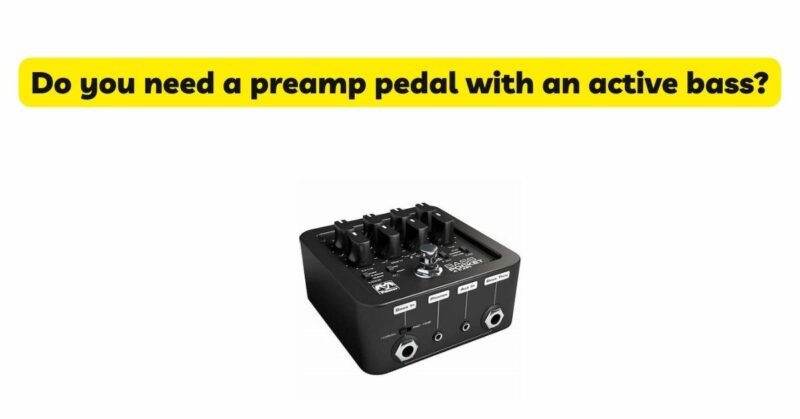Active bass guitars have gained popularity among musicians for their enhanced tonal capabilities and low-noise performance. However, some bassists question whether a preamp pedal is necessary when already equipped with an active bass. In this article, we will delve into the world of active bass guitars and preamp pedals, examining the benefits and considerations of using a preamp pedal with an active bass and exploring whether it is truly essential for achieving the desired bass tone.
Understanding Active Bass Guitars: Active bass guitars differ from passive models by incorporating an onboard preamp powered by a battery. This preamp provides additional control over the instrument’s tone, typically featuring active EQ controls and sometimes even a built-in compressor or other effects. Active basses offer increased output levels and a cleaner, more focused sound due to the boosted signal and lower susceptibility to noise.
Exploring Preamp Pedals: Preamp pedals, on the other hand, are standalone devices designed to simulate the functionality of onboard preamps found in amplifiers and instruments. They allow musicians to shape their tone independently of their bass or amplifier and offer a range of features such as EQ, gain control, and additional effects. Preamp pedals can be used in various setups and configurations to enhance the bass sound.
Benefits of Using a Preamp Pedal with an Active Bass:
- Expanded Tonality: While active bass guitars already provide enhanced tonal possibilities, a preamp pedal can further expand the sonic capabilities. Preamp pedals offer a broader range of EQ controls and tonal shaping options, enabling bassists to sculpt their sound with even greater precision. This versatility allows for the creation of a wider array of tones, making it particularly useful for players who require flexibility across different musical genres.
- Signal Boosting and Control: Preamp pedals often feature gain control, allowing for signal boosting capabilities. This can be beneficial in situations where a stronger signal is needed, such as live performances or recording sessions. Additionally, the gain control on a preamp pedal offers greater control over the overall volume, allowing bassists to easily adjust their levels in different playing environments.
- Effects Integration: Many preamp pedals include additional effects such as compression, overdrive, or modulation. These effects can further shape the bass tone and add unique character and color to the sound. By utilizing a preamp pedal, bassists have the flexibility to experiment with different effects and create more diverse and captivating bass tones.
Considerations when Using a Preamp Pedal with an Active Bass:
- Personal Preference and Tonal Goals: The necessity of a preamp pedal with an active bass ultimately depends on personal preference and the desired tonal goals. Some bassists may find that the tonal capabilities of their active bass meet their requirements without the need for a preamp pedal. Others may seek additional tonal flexibility and prefer the ability to shape their sound independently of the instrument’s onboard preamp.
- Complexity and Setup: Incorporating a preamp pedal into an active bass setup adds another layer of complexity. It requires additional cabling and power supply considerations. Bassists must carefully evaluate their setup and ensure that the addition of a preamp pedal does not introduce unwanted noise, signal loss, or logistical challenges.
- Cost and Budget: Acquiring a preamp pedal involves a financial investment. Before purchasing a preamp pedal, bassists should consider their budget and prioritize their gear acquisitions based on their specific needs and goals. It may be more practical to allocate resources towards other aspects of the bass rig, such as a higher-quality bass or amplifier, before considering a preamp pedal.
Conclusion: While active bass guitars already offer expanded tonal capabilities, the addition of a preamp pedal can further enhance the bassist’s ability to shape their sound. The expanded tonality, signal boosting capabilities, and effects integration provided by preamp pedals can be advantageous in achieving specific tonal goals and musical versatility. However, the decision to use a preamp pedal with an active bass ultimately depends on personal preference, tonal objectives, setup complexity, and budget considerations. It is important for bassists to assess their specific needs and experiment with different configurations to find the optimal setup that allows them to achieve their desired bass tone.


